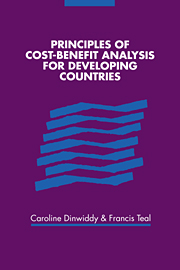Book contents
- Frontmatter
- Contents
- List of figures
- List of economic models and tables
- Preface
- Part I: Introduction to welfare economics
- Part II: Project and policy appraisal in developing countries
- 5 Project appraisal: an overview
- 6 Shadow prices for traded and non-traded commodities in an open economy
- 7 Trade policy, exchange rates and structural adjustment
- 8 Labour markets in developing countries
- 9 The social value of labour
- 10 Intertemporal costs and benefits (1): a market-based approach
- 11 Intertemporal costs and benefits (2): a social planning approach
- Part III: Missing markets
- Retrospect
- Bibliography
- Index
11 - Intertemporal costs and benefits (2): a social planning approach
Published online by Cambridge University Press: 22 October 2009
- Frontmatter
- Contents
- List of figures
- List of economic models and tables
- Preface
- Part I: Introduction to welfare economics
- Part II: Project and policy appraisal in developing countries
- 5 Project appraisal: an overview
- 6 Shadow prices for traded and non-traded commodities in an open economy
- 7 Trade policy, exchange rates and structural adjustment
- 8 Labour markets in developing countries
- 9 The social value of labour
- 10 Intertemporal costs and benefits (1): a market-based approach
- 11 Intertemporal costs and benefits (2): a social planning approach
- Part III: Missing markets
- Retrospect
- Bibliography
- Index
Summary
There are a number of ways in which the consequences of market imperfections for the public sector investment decision can be modelled. In chapter 10 we discussed the approach associated with the name of Harberger. This approach is based on the assumption that market interest rates reflect producer and consumer rates of discount, and examines the consequences of tax distortions which drive a wedge between these two rates. One difficulty with a market-based approach is that the solution to the model requires knowledge of a full set of intertemporal capital markets: the project planner would need to know how interest rates would be affected by the project over its entire lifetime – a formidable information problem. A second difficulty is that, arguably, market rates of interest have no welfare significance for developing countries with highly imperfect capital markets. This view has been very influential in the discussion of investment policy in developing countries (see Marglin, 1963 and UNIDO, 1972). Both practical problems of implementation and doubts about the welfare significance of market-based interest rates have led to the widespread use of a model in which capital market imperfections are modelled by the assumption that savings are a fixed proportion of income. A model of this form was originally developed by Arrow (1966, 1969) to consider public sector investment decisions, and the fixed savings ratio assumption is used by both the major project appraisal manuals of UNIDO and Little and Mirrlees in their discussions of the social value of investment.
- Type
- Chapter
- Information
- Principles of Cost-Benefit Analysis for Developing Countries , pp. 185 - 196Publisher: Cambridge University PressPrint publication year: 1996



